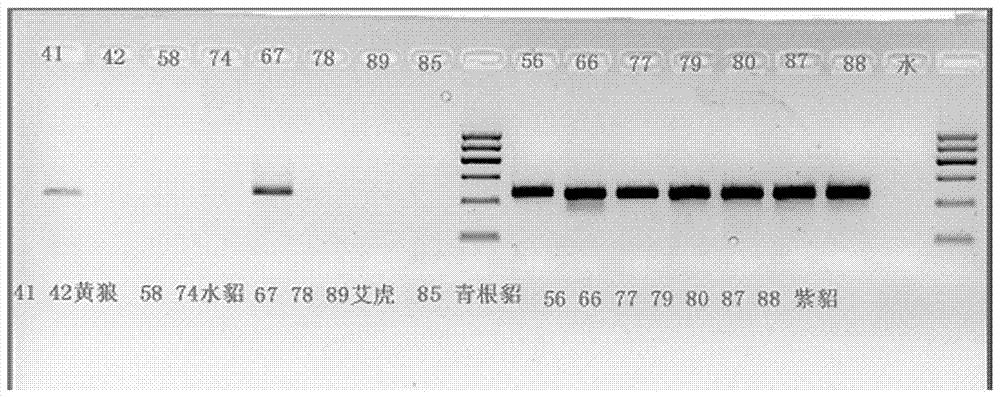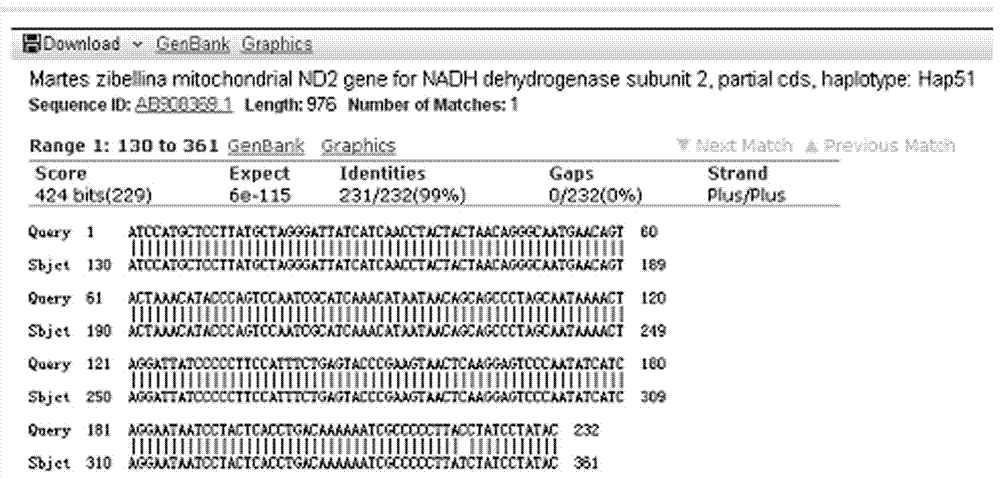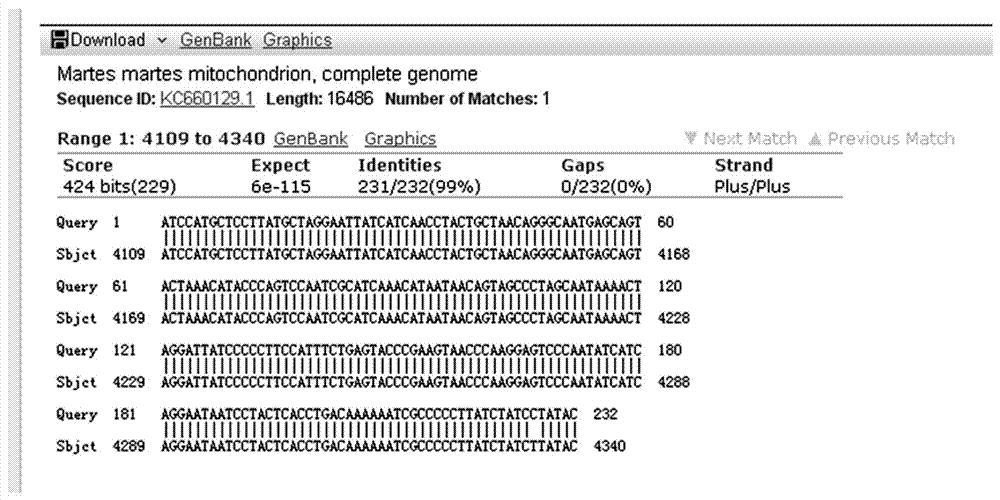Primer and method for identifying animal fur based on PCR technology
A kind of animal and fur technology, applied in the direction of biochemical equipment and methods, recombinant DNA technology, microbial measurement/inspection, etc., can solve the problem of low DNA content, etc., and achieve the effect of simple method, broad application prospect and good specificity
- Summary
- Abstract
- Description
- Claims
- Application Information
AI Technical Summary
Problems solved by technology
Method used
Image
Examples
Embodiment 1
[0068] Example 1 The specificity of the mink primer
[0069] Collected 9 tanned skins of sables and ferrets from domestic large-scale mink sable farms and fur trading markets, and 15 common animal furs that are easily confused. DNA was extracted by the improved CTAB method, and the mink primer was amplified by PCR to detect mink. are ingredients. See Table 2 for sample information.
[0070] Table 2. Sample information used to detect mink specificity
[0071]
[0072]
[0073] Depend on figure 1 It can be seen that the amplification of the positive, negative and blank controls was normal, the target bands were amplified by the mink primers in sable and ferret, and the mink, green root mink, weasel and aihu were all negative; the specificity of the primers was good.
[0074] According to the sequence comparison of the PCR amplification products, the mitochondrial ND2 gene identity between ferret and pine marten (forest mink) Martes martes reached 99%; the mitochondrial ...
Embodiment 2
[0076] Example 2 The Specificity of Ferret Primers
[0077] Collect 18 yellow wolf and aihu tanned skins from domestic large-scale fur animal farms and fur trading markets, as well as 15 common animal furs that are easy to be confused. The DNA is extracted by the improved CTAB method, and the PCR method is used to amplify the weasel primers to detect the weasel. Element. See Table 3 for sample information.
[0078] Table 3. Sample information used to detect ferret specificity
[0079]
[0080]
[0081] Depend on Figure 5 It can be seen that the amplification of the positive, negative and blank controls was normal, the target bands were amplified by the Weasel and Aihu primers, and the mink, Qinggen mink, sable and ferret were all negative; the specificity of the primers was good.
[0082] According to sequence comparison of the PCR amplification products, the mitochondrial ND4 gene identity of the weasel and weasel (Weasel) Mustela sibirica reached 99%; See Figure...
Embodiment 3
[0084] The specificity of embodiment 3 mink primer
[0085] Collected 14 imported and hybrid mink skins from domestic large-scale fur animal farms and fur trading markets, and 13 commonly confused animal furs. DNA was extracted by the improved CTAB method, mink primers were amplified by PCR, and mink components were detected. See Table 4 for sample information.
[0086] Table 4. Sample information used to test mink specificity
[0087]
[0088]
[0089] Depend on Figure 8 It can be seen that the amplification of the positive, negative and blank controls was normal. Among the mink primers, only the mink amplified the target band, and the yellow wolf, aihu, sable and sweeping ferret were all negative; the specificity of the primers was good.
[0090] According to the sequence comparison of the PCR amplification products, the consistency of the mitochondrial COI gene between mink and mink Neovison vison reached 100%. See Figure 9 .
[0091] Detection limit detection ...
PUM
 Login to View More
Login to View More Abstract
Description
Claims
Application Information
 Login to View More
Login to View More - R&D
- Intellectual Property
- Life Sciences
- Materials
- Tech Scout
- Unparalleled Data Quality
- Higher Quality Content
- 60% Fewer Hallucinations
Browse by: Latest US Patents, China's latest patents, Technical Efficacy Thesaurus, Application Domain, Technology Topic, Popular Technical Reports.
© 2025 PatSnap. All rights reserved.Legal|Privacy policy|Modern Slavery Act Transparency Statement|Sitemap|About US| Contact US: help@patsnap.com



